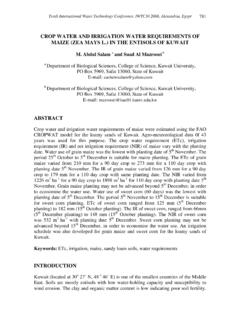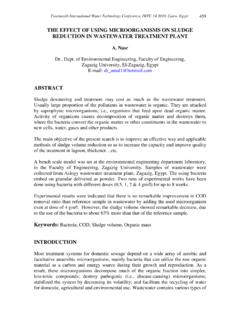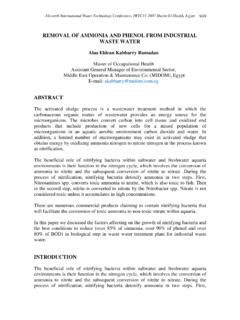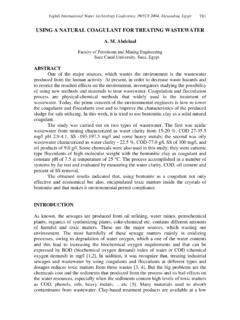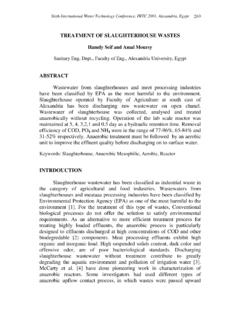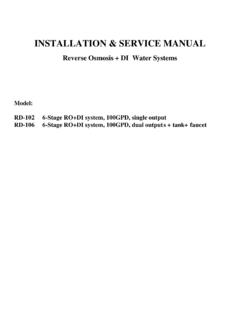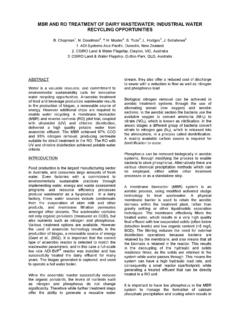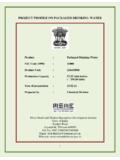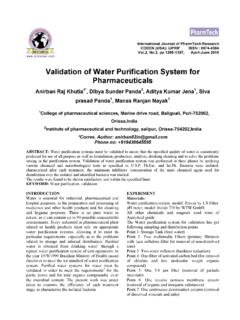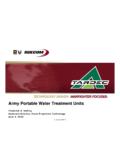Transcription of PERFORMANCE AND CHARACTERISTICS OF …
1 Fourth International water Technology Conference IWTC 99, Alexandria, Egypt 171. PERFORMANCE AND CHARACTERISTICS OF. REVERSE osmosis MEMBRANES. A. M. TOLBA R. A. Mohamed Mechanical Power Engineering Department Chief Chemist, Al-Yosr Desalination &. Faculty of Engineering - Mansoura Purification Plant University, Egypt Hurghada, Egypt ABSTRACT. This paper discusses the PERFORMANCE and CHARACTERISTICS of desalination membranes used in treatment of water for industry and potable use. In this study, a recent advance have been made in spiral wound reverse osmosis membrane elements which make them particularly well suited for desalting high TDS water , such as found in Red Sea and Arabian Gulf. This paper presents the results of the operational PERFORMANCE of RO units in Al-Yosr plant, Hurghada, Red Sea, Egypt.
2 The rate of decline of productivity for a period 48 months was examined and described by simple power law function. The evaluation of the solvent and salt permeability coefficients with the time of operation is quantified. The results show the recovery, pressure and conductivity across the membrane for 365 days test run. Also, the results show the effect of chemical additives and operational parameters on the PERFORMANCE of the membrane during the cleaning. Based on such individual RO module data (one year). the product flow rate and Total Dissolved Solids (TDS) PERFORMANCE is calculated and RO. module replacement ratio can be estimated. Key Words Desalination, spiral wound reverse replacement, module replacement, permeate and PERFORMANCE . INTRODUCTION. Two trade associations oriented toward desalination technology organizes a conference each year and publishes the technical proceedings, namely the International Desalination Association (IDA), the American Desalination Association (ADA)- formally known as the National water Supply Improvement Association (NWSIA).
3 The National water Research Institute (NWRI) has also organized conference and published their proceedings, Also the American water Works Institute (AWWI) publishes a monthly journal which often times includes paper pertaining to desalination technology. Modern research and development of membrane desalination technology is now more than four decades old. An industry offering a wide range of competitive products has developed over the years to meet the drinking water demands of the 21st century. Advancements in membrane materials and other aspects of this technology have lowered overall operating costs, which will ultimately reduce the cost of implementing public water quality improvement programs. Spiral wound elements are normally used in high flow applications [1, 2]. RO. membrane is tested in a quality control test loop before it is shaped under specific 172 Fourth International water Technology Conference IWTC 99, Alexandria, Egypt conditions [3].
4 There are computer models that can simulate the PERFORMANCE of membranes based on feed water CHARACTERISTICS of treatment system. In some tests of membrane an experimental error may be increase due to additional handling and also variations of swatch bench testing may be significant [4]. The fouling film detected on the surface of RO membranes, which is responsible about the decline of RO PERFORMANCE [5]. Membranes generally operate based on three principles and they include (a) Filtration, (b) Diffusion, and (c) Adsorption. Each membrane process utilizes varying degrees of principle to properly function [6]. The operation and maintenance of membrane is very important and normally controlled and monitored by Supervisory Control and Data Acquisition (SCADA) computer software. The primary operation and maintenance factors by SCADA include the following: 1 - Operating pressure 2 - Flux rate 3 - Rejection percentage 4 - Recovery percentage 5 - Fouling 6 - Concentration Polarization 7 - Chemicals 8 - Temperature 9 - Turbidity (1 NTU) 10- p H.
5 11 - Electrical conductivity 12 - Silt density index (SDI). But the membrane life affect by the following factors: (l) Hydrolysis, (2) Operating pressure, (3) Bacterial attack, (4) Chemical degradation, and (5) Fouling. The basic governing equations of the product transport and salt flux through the membrane for steady state, assuming diffusive flow and neglecting leakage, are expressed as [9, 10]: Fw = A ( P - ) (1). Fs = B ( Ct - Cp ) (2). Where the permeability coefficient A and B are defined as: A = DwcwV/(RTL) (3). B = Dscs/(Lc) (4). Over their operating time, the membranes compact resulting reduced the flow capacity. This phenomenon is refereed to as "membrane flux decline" which is expressed as a Membrane Flux Retention Coefficient (MFRC), MFRC = Qpt /Q pi (5). The relationship between Qpt (permeate flow rate at time t) and Qpi (permeate flow rate at initial setup) has been proposed by power law function [11, 12] and given by: Qpt = QPi t-m (6).
6 The Salt Reduction Factor and rejection percent are calculated for the membrane as follow [13]: = (C f /C p ) (7). = ppm in feed water / ppm in product, and % Rejection = [ 1 - (1 ) ] x 100 (8). The goal of this paper is to describe the PERFORMANCE CHARACTERISTICS of spiral wound elements of membrane, in particular the long term's PERFORMANCE of RO units. Also, RO module PERFORMANCE curve versus time can be illustrated. Fourth International water Technology Conference IWTC 99, Alexandria, Egypt 173. MEMBRANE CHARACTERISTICS . In this study spiral type of reverse osmosis modules are used which occupies the smallest space of all the systems available today. The spiral wound modules are constructed from two layers of semi-permeable membrane (aromatic polyamide) of thin film composite (TFC) which are made into a sandwich with a highly micro porous but incompressible backing material inside.
7 The sandwich is wound spirally around a plastic pipe (central pipe) like Swiss roll but with an open weave spacer placed in between to separate adjacent membrane surfaces ( cm diameter by 1 m long) as shown in figure 1(a). Each element contains approximately m2 (300 ft2) of membrane area and a gap mm feed channel spacer. Elements are joined in series by 15 cm long interconnections with up to six elements and installed in a pressure vessel m long and 20 cm diameter, as shown in Figure 1(b). The feed water stream flows axially through the channels between the spiral windings. water permeates through the membrane and flows radially inside the membrane layers towards the central product tube, which passes through one end of the pressure vessel. In this end the concentrated water is outlet without a significant pressure drop inside the pressure vessel.
8 The Fluid System Corporation (FSC) has developed spiral wound elements that display sufficiently high salt rejection ( %) and work under high pressure up to 83 bar. RO membranes are effective in removing Total Dissolved Solids (TDS) in any feed water and up to 40,000 mg/l (ppm) [6]. RO membranes can be distinguished from other membranes based on bore sizes around microns [8] and is so small that it functions primarily by diffusion instead of filtration and adsorption. The specifications of spiral wound module under considerations are given in Table 1. Table 1: Spiral wound specifications Parameters Value TFC membrane module 2282. Membrane length 40" ( cm). Membrane width 8" ( cm). 2 2. Membrane area 300 ft ( m ). Membrane drained weight 40 Ib ( kg). Design rejection %. 3. Design permeate flow rate 5000 gpm ( m /d).
9 Maximum operating pressure 1000 psi (69bar). Allowable operating - cleaning pH range 4-11, Allowable feed water temperature 1 to 45 C. Turbidity 1 NTU. Slit density index (SDI) 5. Test condition: 32800 mg/l NaCI solution (isosmotic to ASTM seawater), 800 psi ( bar), 7% recovery, 25 C and pH Data are collected on each element after 30 minutes of operation at this condition. 174 Fourth International water Technology Conference IWTC 99, Alexandria, Egypt Feed water spacer Feed water Product e water Membranes Feed water spacer Product water side backing with membrane on each side (a) Direction of Flow in Spiral Module End cap 6 Spiral wound element Concentrate brine Permeate Feed Interconnection Pressure vessel (b) Section in Module Pack assembly Figure 1. Spiral Wound Membrane Module TEST SYSTEM DESCRIPTION.
10 Ongoing long-term tests of the TFC (thin film composite) membrane are being conducted at Hurghada city located in Red Sea coast, Egypt. The RO process in AI-Yosr seawater reverse osmosis plant consists of two stages. The first stage RO produces 4800 m3/day with 500 ppm of TDS and 30% recovery. The product of first stage is fed to the second stage and produces 3450 m3/day with 100 ppm of TDS and 80% recovery. A schematic diagram of RO AI-Yosr plant is shown in Figure 2. The feed saline water from Red Sea flow by gravity to intake feed tank (1) through three large PVC pipes (10 m below sea level). This tank provided with screen to prevent fish and other trash to enter the system. A Copper sulfate is added to the water 's tank to control algae and other bio-growth, then pumped to multi media filters (sand filters - 3) by centrifugal pumps (2).
